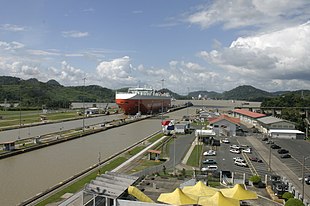 Global Information
Global InformationHistory of the Panama Canal information

The idea of the Panama Canal dates back to 1513, when Vasco Núñez de Balboa first crossed the Isthmus of Panama. This narrow land bridge between North and South America was a fine location to dig a water passage between the Atlantic and Pacific Oceans. The earliest European colonists recognized this, and several proposals for the construction of a canal were made.[1]
By the late nineteenth century, technological advances and commercial pressure allowed construction to begin in earnest. Noted canal engineer Ferdinand de Lesseps led the initial attempt by France to build a sea-level canal. Beset by cost overruns due to the severe underestimation of the difficulties in excavating the rugged terrain, heavy personnel losses to tropical diseases, and political corruption in France surrounding the financing of the massive project, the canal was only partly completed.
Interest in a U.S.-led canal effort picked up as soon as France abandoned the project. Initially, the Panama site was politically unfavorable in the U.S. for a variety of reasons, including the taint of the failed French effort and the unfriendly attitude of the Colombian government (at the time, the owner of the land) towards the U.S. continuing the project. The U.S. first sought to construct a canal through Nicaragua instead.
French engineer and financier Philippe-Jean Bunau-Varilla played a key role in changing American attitudes. Bunau-Varilla had a large stake in the failed French canal company and stood to profit on his investment only if the Panama Canal was completed. His extensive lobbying of American lawmakers, coupled with his support of a nascent independence movement among the Panamanian people, led to a revolution in Panama and to the negotiation of the Hay–Bunau-Varilla Treaty, thus simultaneously securing independence for Panama and an opportunity for the U.S. to lead a renewed effort to construct the canal. Colombia's response to the Panamanian independence movement was tempered by an American military presence; this is often cited as a classic example of the era of gunboat diplomacy. The leaders of the new government in breakaway Panama felt they had no choice but to accept the canal treaty. Had the U.S. withdrawn its warships, the Colombian army would have returned to Panama and executed the members of the new government. "The notion that Roosevelt would abandon Panama at this point, that he would leave the junta to the vengeance of Colombia, that he would now suddenly turn around and treat with Bogota, was not simply without foundation, but ridiculous to anyone the least familiar with the man or the prevailing temper in Washington. Nothing of the kind was ever even remotely contemplated at the White House or the State Department."[2]
The Americans' success hinged on two factors. First was converting the original French sea-level plan (which required extremely large excavations) to a more realistic lock-controlled canal. The second was controlling the diseases which had decimated workers and management alike under the original French attempt. The Americans' chief engineer John Frank Stevens (the second Chief Engineer of the American-led project after John Finlay Wallace resigned out of frustration with the bureaucracy in 1905) built much of the infrastructure necessary for later construction; slow progress on the canal itself led to his replacement by George Washington Goethals. Goethals oversaw the bulk of the excavation of the canal, including appointing Major David du Bose Gaillard to oversee the most daunting project, the Culebra Cut through the roughest terrain on the route. Almost as important as the engineering advances were the healthcare advances made during the construction, led by William C. Gorgas, an expert in controlling tropical diseases such as yellow fever and malaria. Gorgas was one of the first to recognize the role of mosquitoes in the spread of these diseases and, by focusing on controlling the mosquitoes, greatly improved worker conditions.
On 7 January 1914, the French crane boat Alexandre La Valley became the first to traverse the entire length of the canal, and on 1 April 1914 the construction was officially completed with the hand-over of the project from the construction company to the Panama Canal Zone government. The outbreak of World War I caused the cancellation of any official "grand opening" celebration, but the canal officially opened to commercial traffic on 15 August 1914 with the transit of the SS Ancon.
During World War II, the canal proved vital to American military strategy, allowing ships to transfer easily between the Atlantic and Pacific. Politically, the canal remained a territory of the United States until 1977, when the Torrijos–Carter Treaties began the process of transferring territorial control of the Panama Canal Zone to Panama, a process which was finally completed on 31 December 1999.
The Panama Canal continues to be a viable commercial venture and a vital link in world shipping, and is periodically upgraded. A Panama Canal expansion project started construction in 2007 and began commercial operation on 26 June 2016. The new locks allow the transit of larger Post-Panamax and New Panamax ships, which have greater cargo capacity than the original locks could accommodate.[3]
- ^ Smith, Lydia (August 15, 2014). "Panama Canal 100th Anniversary". International Business Times. Retrieved May 12, 2015.
- ^ The Path Between the Seas: The Creation of the Panama Canal, 1870–1914, David McCullough, Simon & Schuster, 1978, p.396
- ^ Cite error: The named reference
NYT062016was invoked but never defined (see the help page).